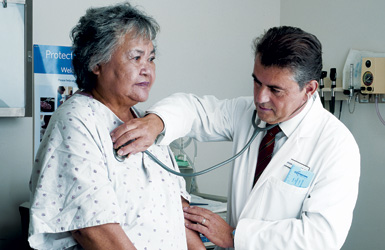Lead Story
Medical Oncology Redefined:
A Conversation with the New Chief of the Medical Oncology Branch at CCR
Defining the discipline of medical oncology can be more difficult than one would initially think because it touches on so many aspects of cancer research and care. Most broadly, it can be defined as the care and study of adult cancers. Some categorize it as a subspecialty of internal medicine that provides chemotherapy and other non-radiation and non-surgical treatments, a definition that comes close to that of Giuseppe Giaccone, M.D., Ph.D., Chief of the Medical Oncology Branch (MOB) at CCR. "Medical oncology is the medical treatment of cancer,” he noted, "which covers all that is not surgery or radiotherapy."

The Medical Oncology Branch brings resources, technologies, and people—researchers, clinicians, and patients—from across NCI and beyond together in ways that leverage the insights and capabilities of multiple clinical and scientifi c disciplines for the benefit of cancer patients worldwide.
That definition is changing, becoming more translational, more research oriented, and more reflective of the heterogeneity found among patients with the same or similar diagnoses. "Medical oncology also means understanding the range of treatments and identifying the best treatment for each unique patient," Giaccone said. "It no longer means treating everyone the same, a shift in practice that really is only happening now."
The nature of the research and organization of medical oncology is also changing to meet this new definition, a shift that is reflected in the efforts underway at CCR to revitalize the Medical Oncology Branch. Giaccone, a lung cancer specialist trained in the former NCI Medicine Branch, rejoined NCI last year as its Chief of Medical Oncology after 16 years at the Free University Medical Center in the Netherlands. His task: to revitalize the Branch as a translational research powerhouse by forging closer ties among the labs and sections comprising CCR's medical oncology community; to recruit new leaders in key disease areas such as gastrointestinal (GI) and head and neck; to foster relationships between the MOB and extramural investigators; and to build effective partnerships with industry.
CCR Connections had a conversation with Giaccone about CCR's vision for the new MOB and the Center's goals for collaboratively leveraging the unique resources of CCR and the MOB to accelerate the national cancer research effort.
Connections: How was medical oncology research conducted within NCI in the past?
Giaccone: Until recently, cancer biologists were not involved in patient treatment; the provision of systemic therapy largely fell to trained medical oncologists. With the growing translation of biological insights into targeted therapies, many CCR labs and branches have become more interested and involved in bringing treatments to our patients. While this is a very positive development, it requires increased coordination within the MOB and between medical oncologists and our colleagues in the laboratory. In fact, I believe the MOB should be at the forefront of delivering new treatments to our patients.
There are attributes of the old NCI Medicine Branch, particularly its collaborative, multidisciplinary nature, that can serve us well in translating the scientific and medical advances—such as advanced technologies for genomic screening, tools for linking patients' clinical histories and outcomes with the molecular characteristics of their tumors, and enhanced techniques, including imaging, for investigating the efficacy and activity of new therapies, particularly targeted therapies—in clinical practice.
All of these advances, if they are to impact cancer prevention and care, require the contributions of multiple fields of expertise in their development and application. Based on this reasoning, we have thus far focused on facilitating greater integration and coordination across the different components of CCR that engage in medical oncology research.
Connections: Please define CCR's vision for the new MOB.
Giaccone: Medical oncology can only work when the strengths and expertise of numerous fields—immunology, molecular biology, translational medicine, etc.—are leveraged in an integrated, coordinated fashion. The MOB is the largest CCR branch practicing the discipline of medical oncology. As such, it will provide a framework for conducting all medical oncology research at CCR, bringing all of the sections, branches, and laboratories together to make joint strategic decisions about how to move forward in advancing cancer research.
Connections: Where do you see the new MOB fitting within the larger medical oncology community?

Giuseppe Giaccone, M.D., Ph.D. (right), a thoracic oncologist by training, examines a patient at CCR.
Giaccone: We were once highly regarded for our cutting-edge capabilities in translational and clinical research, and for the resources we brought to the table. However, as our internal research efforts became fragmented, we lost this reputation. With the revitalization of the MOB, we want the cancer community to understand that we have an important role to play in translational cancer research: that of a high intensity clinical research center that is ideally suited to bring advanced treatments to patients in a highly integrated research setting.
Medical oncology can only work when the strengths and expertise of numerous fields–immunology, molecular biology, translational medicine, etc.–are leveraged in an integrated, coordinated fashion.
Over the last few years, both NCI and CCR have recognized the need to remove barriers to both internal and external collaboration and have undertaken significant efforts to do so. We need to partner with other institutions in order to share additional and unique areas of expertise. The new MOB will be an interactive part of the oncology community, with active involvement in a broad portfolio of multicenter studies, where we can leverage our unique resources to carry out experiments that are not feasible outside of CCR.
Connections: One of the main factors in the fragmentation of the old Medicine Branch was the concern that this intramural program was too similar in scope and activity to external programs. How are you addressing this concern now?
Giaccone: The new MOB needs to be able to differentiate itself significantly from what can be done in academia or industry and position itself as a complementary resource for such groups.
We have unique abilities in translational medical oncology research due in large part to our unique patient populations. From day one, CCR has focused on rare tumor types. It is relatively easy for CCR to gather patients with rare cancers from around the country and the globe and run complicated studies—such as molecular imaging studies over a regular timeframe or mechanism-of-action studies—that would be difficult and expensive to coordinate on the outside.
Because we are a clinical research center and not an academic or community hospital, we are able to take that relatively small number of patients and study them very intensively, allowing us to gain a deep understanding of these tumors from multiple points of view, including genomics and imaging, two critical areas of targeted treatment research that can be very resource-, infrastructure-, and time-intensive.
Connections: Do you see greater collaboration with industry as part of the branch’s reformation?


